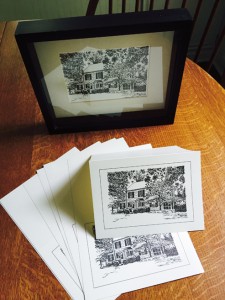House Stationery: Hits the Right Note
 In our technology-driven daily lives, an “old-fashioned” handwritten note, in many ways, has become even more of an extra-special treat to receive. Your time and effort in writing a hand-penned letter warms the heart of your recipient—especially if it’s clear the note has been personalized.
In our technology-driven daily lives, an “old-fashioned” handwritten note, in many ways, has become even more of an extra-special treat to receive. Your time and effort in writing a hand-penned letter warms the heart of your recipient—especially if it’s clear the note has been personalized.
Personalize not only what you have to say, but your stationery too! Of course, you can order stationery from fine stationery retailers imprinted with your name or monogram. Or, with just a little bit more effort, you can create something truly one-of-a-kind to become your “house” stationery—complete with a custom sketch of your home printed upon it!
Folded notes are typically used to write thank you notes, extend informal invitations and send short messages to friends and acquaintances—and the front page of a folded note was practically made for showcasing such a special image. Imagine the delight of your letter’s recipient as she opens the envelope to see a rendering of your home—that beacon of hospitality!
How might you obtain a sketch or drawing of your home that’s worthy of being printed on a notecard? There are many options.
Commission a Local Artist
Perhaps the loveliest way to customize your house stationery is to work with an artist from your community. Commissioning an artist is not just for the rich and famous; you might be pleasantly surprised at how affordable it can be. The best way to get to know artists is to become active in your local art scene. Read your community calendar to find out when local art events are taking place, and attend them. Autumn in Virginia is ripe with opportunities to meet artists at “open studio” events, galleries, fairs and festivals. Stroll around, admire their work and get a feel for various artists’ styles until you find the one whose style matches your own. The artists are typically available to speak with you and share their contact information; many even have their own websites, where you can see more examples of their work. You might also contact your local art supply store, tell them about your project, and ask them for recommendations. Or, if you like the idea of supporting young artists in training, you could even reach out to the art departments at local high schools or colleges.
 Please be certain to inform the artist of what you intend to do with the sketch they create for you, in case you need to obtain their permission to have it printed/replicated onto your new stationery. It’s not uncommon for printers to seek verification that an artist/photographer has given their permission for you to use their artistry in that way. Once you have your custom artwork in hand, the next step is to take it to a local printer to have the image printed on notecard paper of your choosing. By using a printer, you will have access to the highest-possible quality image, printing and paper selection for your special notecards. You can also choose matching envelopes and have your return address printed on them.
Please be certain to inform the artist of what you intend to do with the sketch they create for you, in case you need to obtain their permission to have it printed/replicated onto your new stationery. It’s not uncommon for printers to seek verification that an artist/photographer has given their permission for you to use their artistry in that way. Once you have your custom artwork in hand, the next step is to take it to a local printer to have the image printed on notecard paper of your choosing. By using a printer, you will have access to the highest-possible quality image, printing and paper selection for your special notecards. You can also choose matching envelopes and have your return address printed on them.
When you hire an artist to complete your project, remember that not only will you have your notecards, you’ll get to keep the original artwork too—perhaps to frame and display in your home as a keepsake.
 Artists Who Work From Photographs
Artists Who Work From Photographs
Did you know it’s possible to search for an artist-for-hire on the internet—one who can work from a photograph to create a custom work of art? As with any online shopping experience, if you select a reputable website, the process should be a cut-and-dried agreement. You’ll provide a photo (or several) of your home from which the artist will work. Most are happy to provide a proof of the work before it’s finalized, to ensure you’re fully satisfied with their work. Many websites even offer a turnkey service of having the image transposed onto stationery for you, saving you the legwork of that step in the design process. Depending on the look you want, you will be able to find artists who can work from photographs to create styles ranging from animated, cartoon-like drawings, classic pen-and-ink or charcoal/pencil sketches, or even colorful watercolor, acrylic or oil paintings.
 Graphic Designers, Computer Software and Online Tools
Graphic Designers, Computer Software and Online Tools
Tech-savvy do-it-yourselfers can use computer software or online tools of choice to alter a digital photograph into an image that looks just like a hand-drawn architectural sketch, which can then be uploaded to a printer or online stationery website. Or you can hire a graphic designer to do the work for you, if you’d rather rely on their expertise in manipulating digital photographs and computer software. Graphic designers and printers often have working relationships that go hand-in-hand, and they can handle the print shop step for you, usually for an additional small fee.
There are many ways to add the image of your home onto special notecards that you’ll be proud to send to your friends and family. If you’ve recently completed a big renovation project, send your holiday greetings on your new house stationery to share the news. (You could even add spots of holiday color by inking on little wreaths and festive red bows onto the windows and front door by hand, with green and red felt markers!) These notes make great change-of-address notifications too. You could also announce other special news from your household, like the arrival of a new baby or the celebration of a graduation. Personalized “house” stationery makes a terrific housewarming gift for new homeowners, or a lovely present for anybody who loves their home—including you.
WRITING A NOTE-EASY AS 1-2-3
Three Days
It’s best to write a note within three days of an event or receiving a gift—though, it’s never too late to express your feelings, so don’t be embarrassed if more time than that has lapsed. Send a note (you’ll be glad you did).
Three Lines Long
Not including the note’s salutation or closing, a well-constructed note can be as short as three lines long. The first line is for expressing gratitude and specific acknowledgement of the person, event or gift. The second line can state a specific memory about the person or the event you attended—or, in the case of a gift, a specific acknowledgement about how you’ll use it or why you appreciate it. The third line is for stating your hopeful anticipation for the next time you and your friend will get to see each other again.
Source: The Emily Post Institute
Artist for Hire, House Sketch, House Stationery, Note Cards, Online Stationery Website, Stationery Monogram






